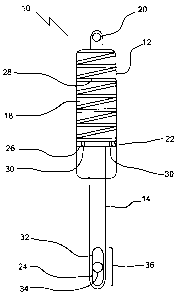Some of the information on this Web page has been provided by external sources. The Government of Canada is not responsible for the accuracy, reliability or currency of the information supplied by external sources. Users wishing to rely upon this information should consult directly with the source of the information. Content provided by external sources is not subject to official languages, privacy and accessibility requirements.
Any discrepancies in the text and image of the Claims and Abstract are due to differing posting times. Text of the Claims and Abstract are posted:
| (12) Patent Application: | (11) CA 2575089 |
|---|---|
| (54) English Title: | SHOCK ABSORBER |
| (54) French Title: | AMORTISSEUR |
| Status: | Deemed Abandoned and Beyond the Period of Reinstatement - Pending Response to Notice of Disregarded Communication |
| (51) International Patent Classification (IPC): |
|
|---|---|
| (72) Inventors : |
|
| (73) Owners : |
|
| (71) Applicants : |
|
| (74) Agent: | DOUGLAS B. THOMPSONTHOMPSON, DOUGLAS B. |
| (74) Associate agent: | |
| (45) Issued: | |
| (22) Filed Date: | 2007-01-17 |
| (41) Open to Public Inspection: | 2008-07-17 |
| Availability of licence: | N/A |
| Dedicated to the Public: | N/A |
| (25) Language of filing: | English |
| Patent Cooperation Treaty (PCT): | No |
|---|
| (30) Application Priority Data: | None |
|---|
A shock absorber includes a first body having an internal cavity. A first
mounting is
provided on the first body. An elongated second body is telescopically
received within the
internal cavity of the first body. Dampening means are positioned within the
internal cavity
of the first body and adapted to dampen telescopic movement of the second body
relative to
the first body. A second mounting is provided on the second body. The second
mounting is a
slot adapted to receive a mounting pin. The slot defines a free travel limit
for the mounting
pin. Movement of the mounting pin within the slot caused by vibrations and
oscillations does
not energize the dampening means unless such movement exceeds the free travel
limit
defined by the slot.
Note: Claims are shown in the official language in which they were submitted.
Note: Descriptions are shown in the official language in which they were submitted.

2024-08-01:As part of the Next Generation Patents (NGP) transition, the Canadian Patents Database (CPD) now contains a more detailed Event History, which replicates the Event Log of our new back-office solution.
Please note that "Inactive:" events refers to events no longer in use in our new back-office solution.
For a clearer understanding of the status of the application/patent presented on this page, the site Disclaimer , as well as the definitions for Patent , Event History , Maintenance Fee and Payment History should be consulted.
| Description | Date |
|---|---|
| Time Limit for Reversal Expired | 2010-01-18 |
| Application Not Reinstated by Deadline | 2010-01-18 |
| Deemed Abandoned - Failure to Respond to Maintenance Fee Notice | 2009-01-19 |
| Application Published (Open to Public Inspection) | 2008-07-17 |
| Inactive: Cover page published | 2008-07-16 |
| Inactive: IPC assigned | 2008-07-10 |
| Inactive: Adhoc Request Documented | 2008-01-02 |
| Revocation of Agent Request | 2007-11-16 |
| Appointment of Agent Request | 2007-11-16 |
| Inactive: First IPC assigned | 2007-11-08 |
| Inactive: IPC assigned | 2007-11-08 |
| Inactive: IPC assigned | 2007-11-08 |
| Application Received - Regular National | 2007-02-21 |
| Filing Requirements Determined Compliant | 2007-02-21 |
| Inactive: Filing certificate - No RFE (English) | 2007-02-21 |
| Abandonment Date | Reason | Reinstatement Date |
|---|---|---|
| 2009-01-19 |
| Fee Type | Anniversary Year | Due Date | Paid Date |
|---|---|---|---|
| Application fee - small | 2007-01-17 |
Note: Records showing the ownership history in alphabetical order.
| Current Owners on Record |
|---|
| MARK DAVIS |
| Past Owners on Record |
|---|
| None |